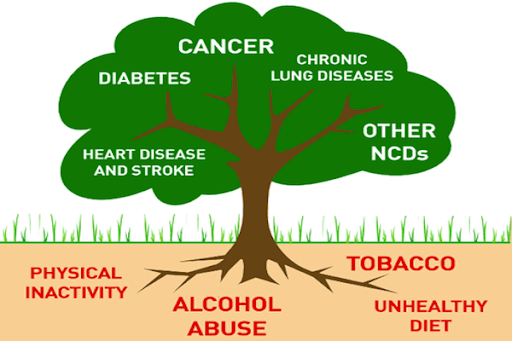Every year, roughly 5.8 million Indians die from heart and lung diseases, stroke, cancer and diabetes. In other words, 1 in 4 Indians risks dying from an NCD before they reach the age of 70.

WHO/SEARO/Payden
“Heart diseases, diabetes, cancers, and chronic respiratory diseases now affect younger and younger people,” says Dr Poonam Khetrapal Singh, Regional Director of WHO South-East Asian Region. “The millions of productive individuals lost prematurely to NCDs are seriously undermining social and economic development.”

But the country is not watching and waiting for the burden to grow. Instead, the Government of India is taking immediate action and targeting the greatest risk factors contributing to NCDs—unhealthy diets, physical inactivity, tobacco and alcohol use, and air pollution.
Specific national targets and indicators
In line with WHO’s Global action plan for the prevention and control of NCDs 2013-2020, India is the first country to develop specific national targets and indicators aimed at reducing the number of global premature deaths from NCDs by 25% by 2025. A National Multisectoral Action Plan that outlines actions by various sectors in addition to the health sector, to reduce the burden of NCDs and their risk factors, is in the final stage of development.
“It is heartening to see the Government of India taking the leadership role in the prevention and control of NCDs,” says Dr Nata Menabde, WHO Representative to India. “As a partner to the global agenda on prevention and control of NCDs, we are committed to supporting national efforts towards strengthening the health systems to address the growing burden of NCDs and comorbidities.”
“Heart diseases, diabetes, cancers, and chronic respiratory diseases now affect younger and younger people.” Dr Poonam Khetrapal Singh, Regional Director of WHO South-East Asian Region
10th target: household air pollution
The global action plan lists 9 targets for countries to set. But India has taken the unprecedented step of setting the tenth target to address household air pollution —a major health hazard in the South-East Asian Region due to burning of solid biomass fuel and secondhand smoke.
Globally, 4 million deaths are caused by exposures to household (indoor) air pollution and 3.7 million deaths are attributed to outdoor air pollution. Approximately 40% of the deaths from indoor air pollution and 25% of those attributed to outdoor air pollution occur in the WHO South-East Asia Region.

“We must act to protect people from air pollution. The poor, living near busy roads or industrial sites, are disproportionately affected by air pollution,” says Dr Poonam Khetrapal Singh. “Women and children pay the heaviest price, as they spend more time at home breathing in smoke and soot from cooking stoves.
India’s National Monitoring Framework for Prevention and Control of NCDs calls for a 50% relative reduction in household use of solid fuel and a 30% relative reduction in prevalence of current tobacco use by 2025. Countries in the South-East Asia Region have also committed to reducing household air pollution as part of the Regional Acton Plan for the Prevention and Control of Noncommunicable Diseases 2013-2020.
Implementing the WHO’s Framework Convention on Tobacco Control

Additionally, India has implemented the WHO’s Framework Convention on Tobacco Control aimed at reducing the demand for tobacco products. The country has prohibited sales of tobacco products around educational institutions, restricted tobacco imagery in films and TV programmes, banned some smokeless tobacco products and developed tobacco-free guidelines for educational institutions. In April 2015, the country will go a step further and require tobacco pictorial warnings to cover 85% of the package. This effort is an excellent example of a “best buy” or cost-effective, high impact intervention for combating NCDs.


Your article gave me a lot of inspiration, I hope you can explain your point of view in more detail, because I have some doubts, thank you.
I don’t think the title of your article matches the content lol. Just kidding, mainly because I had some doubts after reading the article.
Your point of view caught my eye and was very interesting. Thanks. I have a question for you.
Your point of view caught my eye and was very interesting. Thanks. I have a question for you.
I don’t think the title of your article matches the content lol. Just kidding, mainly because I had some doubts after reading the article.
Your article helped me a lot, is there any more related content? Thanks!
Thanks for sharing. I read many of your blog posts, cool, your blog is very good.
I don’t think the title of your article matches the content lol. Just kidding, mainly because I had some doubts after reading the article.
Thank you for your sharing. I am worried that I lack creative ideas. It is your article that makes me full of hope. Thank you. But, I have a question, can you help me?